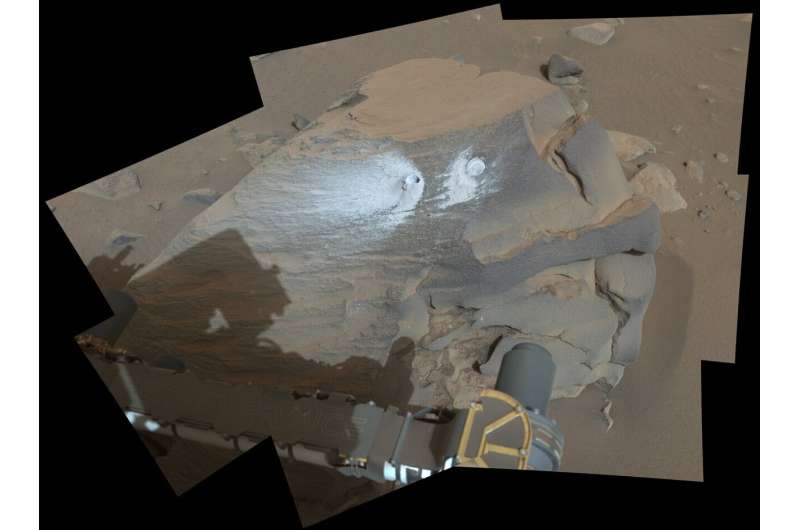This article has been reviewed according to Science X's editorial process and policies. Editors have highlighted the following attributes while ensuring the content's credibility:
fact-checked
trusted source
proofread
Rock sampled by NASA's Perseverance embodies why rover came to Mars

The 24th sample taken by the six-wheeled scientist offers new clues about Jezero Crater and the lake it may have once held.
Analysis by instruments aboard NASA's Perseverance Mars rover indicate that the latest rock core taken by the rover was awash in water for an extended period of time in the distant past, perhaps as part of an ancient Martian beach. Collected on March 11, the sample is the rover's 24th—a tally that includes 21 sample tubes filled with rock cores, two filled with regolith (broken rock and dust), and one with Martian atmosphere.
"To put it simply, this is the kind of rock we had hoped to find when we decided to investigate Jezero Crater," said Ken Farley, project scientist for Perseverance at Caltech in Pasadena, California. "Nearly all the minerals in the rock we just sampled were made in water; on Earth, water-deposited minerals are often good at trapping and preserving ancient organic material and biosignatures. The rock can even tell us about Mars climate conditions that were present when it was formed."
The presence of these specific minerals is considered promising for preserving a rich record of an ancient habitable environment on Mars. Such collections of minerals are important for guiding scientists to the most valuable samples for eventual return to Earth with the Mars Sample Return campaign.
Edge of the crater's rim
Nicknamed "Bunsen Peak" for the Yellowstone National Park landmark, the rock—about 5.6 feet wide and 3.3 feet high (1.7 meters by 1 meter)—intrigued Perseverance scientists because the outcrop stands tall amid the surrounding terrain and has an interesting texture on one of its faces. They were also interested in Bunsen Peak's vertical rockface, which offers a nice cross-section of the rock and, because it's not flat-lying, is less dusty and therefore easier for science instruments to investigate.
Before taking the sample, Perseverance scanned the rock using the rover's SuperCam spectrometers and the X-ray spectrometer PIXL, short for Planetary Instrument for X-ray Lithochemistry. Then the rover used the rotor on the end of its robotic arm to grind (or abrade) a portion of the surface and scanned the rock again. The results: Bunsen Peak looks to be composed of about 75% carbonate grains cemented together by almost pure silica.
"The silica and parts of the carbonate appear microcrystalline, which makes them extremely good at trapping and preserving signs of microbial life that might have once lived in this environment," said Sandra Siljeström, a Perseverance scientist from the Research Institutes of Sweden (RISE) in Stockholm.
"That makes this sample great for biosignature studies if returned to Earth. Additionally, the sample might be one of the older cores collected so far by Perseverance, and that is important because Mars was at its most habitable early in its history." A potential biosignature is a substance or structure that could be evidence of past life but may also have been produced without the presence of life.
The Bunsen Peak sample is the third that Perseverance has collected while exploring the "Margin Unit," a geologic area that hugs the inner edge of Jezero Crater's rim.
"We're still exploring the margin and gathering data, but results so far may support our hypothesis that the rocks here formed along the shores of an ancient lake," said Briony Horgan, a Perseverance scientist from Purdue University, in West Lafayette, Indiana. "The science team is also considering other ideas for the origin of the Margin Unit, as there are other ways to form carbonate and silica. But no matter how this rock formed, it is really exciting to get a sample."
The rover is working its way toward the westernmost portion of the Margin Unit. At the base of Jezero Crater's rim, a location nicknamed "Bright Angel" is of interest to the science team because it may offer the first encounter with the much older rocks that make up the crater rim. Once it's done exploring Bright Angel, Perseverance will begin an ascent of several months to the rim's top.
Provided by NASA





















